
The 1st Special Forces Operational Detachment–Delta, referred to variously as Delta Force, Combat Applications Group (CAG), or within Joint Special Operations Command (JSOC), Task Force Green, is a special operations force of the United States Army, under operational control of JSOC. The unit's missions primarily involve counterterrorism, hostage rescue, direct action, and special reconnaissance, often against high-value targets.
United States special operations forces (SOF) are the active and reserve component forces of the United States Army, Marine Corps, Navy and Air Force within the US military, as designated by the Secretary of Defense and specifically organized, trained, and equipped to conduct and support special operations. All active and reserve special operations forces are assigned to the United States Special Operations Command (USSOCOM).

Air Force Special Operations Command (AFSOC), headquartered at Hurlburt Field, Florida, is the special operations component of the United States Air Force. An Air Force major command (MAJCOM), AFSOC is also the U.S. Air Force component command to United States Special Operations Command (USSOCOM), a unified combatant command located at MacDill Air Force Base, Florida. AFSOC provides all Air Force Special Operations Forces (SOF) for worldwide deployment and assignment to regional unified combatant commands.
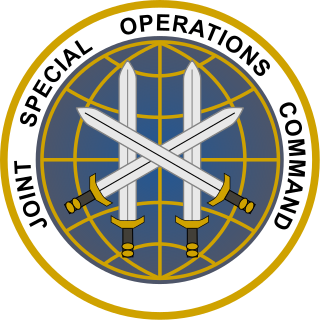
The Joint Special Operations Command (JSOC) is a joint component command of the United States Special Operations Command (USSOCOM) and is charged with studying special operations requirements and techniques to ensure interoperability and equipment standardization, to plan and conduct special operations exercises and training, to develop joint special operations tactics, and to execute special operations missions worldwide. It was established in 1980 on recommendation of Colonel Charlie Beckwith, in the aftermath of the failure of Operation Eagle Claw. It is headquartered at Pope Field.
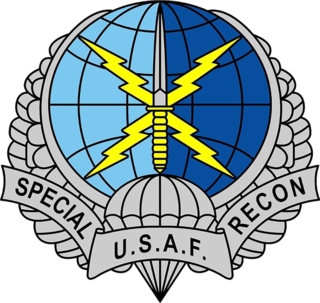
Special Reconnaissance (SR), formerly Special Operations Weather Technician or Team (SOWT), is conducted by trained Air Force personnel assigned to Special Tactics Squadrons of the United States Air Force Special Operations Command who operate deep behind enemy lines to conduct covert direction of air and missile attacks, place remotely monitored sensors, and support other special operation units. Like other special operations units, SR units may also carry out direct action (DA) and unconventional warfare (UW), including guerrilla operations. As SOWTs they were tactical observer/forecasters with ground combat capabilities and fell under the Air Force Special Tactics within the Air Force Special Operations Command (AFSOC). The mission of a Special Operations Weather Technician was to deploy by the most feasible means available into combat and non-permissive environments to collect and interpret meteorological data and provide air and ground forces commanders with timely, accurate intelligence. They collect data, assist mission planning, generate accurate and mission-tailored target and route forecasts in support of global special operations, conduct special weather reconnaissance and train foreign national forces. SOWTs provided vital intelligence and deployed with joint air and ground forces in support of direct action, counter-terrorism, foreign internal defense, humanitarian assistance, special reconnaissance, austere airfield, and combat search and rescue.
The term Special Missions Unit (SMU), at one time referred to as a "Tier 1" unit, is used in the United States to categorize the nation's most highly secretive and elite military special operations forces. The term "special missions unit" is also used in Australia to describe the Special Air Service Regiment. Special mission units have been involved in high-profile military operations, such as the killing of Osama bin Laden and the attempted hostage rescue of Kayla Mueller.

The United States Air Force Combat Control Teams, singular Combat Controller (CCT), are an elite special operations force who specialize in all aspects of air-ground communication, as well as air traffic control, fire support, and command, control, and communications in covert, forward, or austere environments.

Operation Rhino was a raid led by the United States Army's 75th Ranger Regiment and, who were led by Colonel Joseph Votel, and other SOCOM units on several Taliban targets in and around Kandahar, Afghanistan during the invasion of Afghanistan at the start of the War in Afghanistan. The operation was motivated by a desire for the White House and Tommy Franks to capture video footage of special forces parachuting deep into enemy territory. Intelligence reports at the time indicated that the targeted airfield was empty, leading them to believe that the Rangers would face no resistance from the Taliban. The operation has faced subsequent criticism for its focus on media portrayal rather than solely military objectives.

The 23rd Special Tactics Squadron is an active ground unit, within the 24th Special Operations Wing United States Air Force Special Operations Command (AFSOC). It is garrisoned at Hurlburt Field, Florida. The 23rd STS was previously designated the 1723rd Special Tactics Squadron prior to 1992.

The United States Air Force Special Operations Training Center (AFSOTC) was located at Hurlburt Field, Florida. It worked under the supervision of the Air Force Special Operations Command (AFSOC); Its primary function was to train the Air Force's Special Operations Personnel before being assigned to their respective units. The Mission Statement/Vision was, "Transforming Airmen into Air Commandos who possess the specialized skills and warrior ethos to fight and win anytime, anywhere." The AFSOTC was replaced 11 February 2013 by the Air Force Special Operations Air Warfare Center.

A United States Air Force Tactical Air Control Party, commonly abbreviated TACP, is an individual or team of United States Air Force Special Warfare Airmen with AFSC 1Z3X1, who are aligned with conventional, Special Operation Forces, and Tier 1 combat maneuver units. They provide precision terminal attack control and terminal attack guidance of U.S. and coalition fixed- and rotary-wing close air support aircraft, artillery, and naval gunfire; establish and maintain command and control (C2) communications; and advise ground commanders on the best use of air power.

The 720th Special Tactics Group is one of the special operations ground components of the 24th Special Operations Wing, assigned to Air Force Special Operations Command (AFSOC) of the United States Air Force. The group is headquartered at Hurlburt Field, Florida. The group is composed of geographically separated squadrons in four separate states; Florida, New Mexico, North Carolina and Washington.
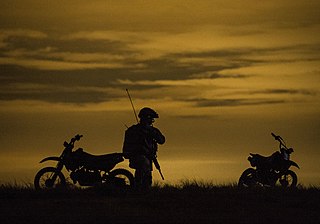
The 21st Special Tactics Squadron is one of the special tactics units of the United States Air Force Special Operations Command. It is garrisoned at Pope Field, North Carolina.
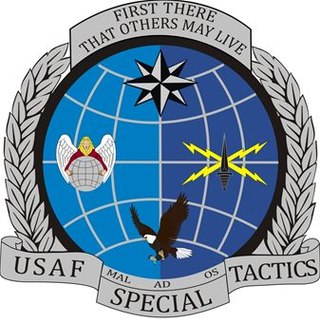
A United States Air Force Special Tactics Officer is a United States Air Force Special Operations Command (AFSOC) Special Warfare Officer who manages the training and equipping of U.S. Air Force ground special operations. Special Tactics Officers deploy as team leaders or mission commanders in combat, seizing and controlling airstrips, combat search and rescue, guiding airstrikes and fire support using air assets for special operations and tactical weather observations and forecasting. Special Tactics Officers are not Pararescuemen, Combat Controllers, or Special Reconnaissance, but they lead the Special Tactics Squadrons and Groups and thoroughly understand how to conduct, manage, and provide these special operations missions to both conventional and joint special operations missions needed within Joint Special Operations Command (JSOC) and United States Special Operations Command (SOCOM).

The 724th Special Tactics Group is one of the special operations ground components of the 24th Special Operations Wing, assigned to Air Force Special Operations Command (AFSOC). The Group is headquartered at Pope Field, North Carolina. The Group is composed of four squadrons, also located on Pope Field.
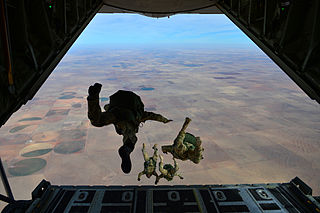
The 26th Special Tactics Squadron is one of the Special Tactics units of the United States Air Force Special Operations Command (AFSOC). It is garrisoned at Cannon Air Force Base, New Mexico. From 1991 to 1992, the squadron's predecessor, the 7026th Special Activities Squadron was stationed in Europe.

The 17th Special Tactics Squadron is one of the ten Special Tactics Squadrons of United States Air Force Special Operations Command. It is garrisoned at Fort Moore, Georgia.
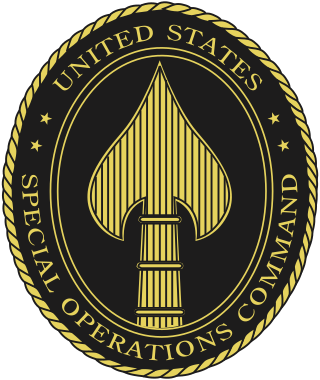
The United States Special Operations Command is the unified combatant command charged with overseeing the various special operations component commands of the Army, Marine Corps, Navy, and Air Force of the United States Armed Forces. The command is part of the Department of Defense and is the only unified combatant command created by an Act of Congress. USSOCOM is headquartered at MacDill Air Force Base in Tampa, Florida.

The 22nd Special Tactics Squadron is a Special Tactics unit of the United States Air Force Special Operations Command, based at the McChord Air Force Base facility of Joint Base Lewis–McChord.






















